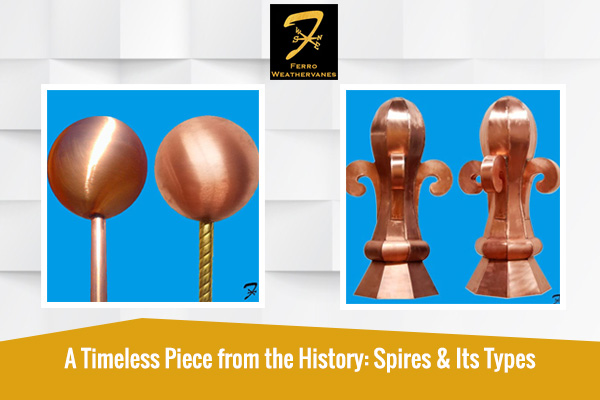Spires have been used as a piece of external decoration for ages. These tall, slender, pointed, and conical or pyramidal shape structures are usually placed on the top of a roof or tower. Spires are made from timber, stonework, or brickwork structure that has shingles, ceramic tiling, metal cladding, or slates on the outside. Originated in the 12th century, spires were used for capping a church tower. Now they are customarily used to beautify the outer appearance of any building.
Copper spires are widely popular
worldwide because it has a finishing touch of timeless elegance. They
gracefully embellish cabanas or pergolas and beautify gardens as well as
landscapes.
What are the conventional types of spires -
Since spires have been used for
several years, there are many variations introduced by people from parts of the
world. Here we have mentioned a few of them -
1. Conical stone spires -
Usually placed on circular
towers and turrets, these spires have a smaller diameter than others.
2. Masonry spires -
These kinds of spires are
usually found on medieval and revival churches and cathedrals. The most
commonly found masonry spires are pyramidal or octagonal, which are supported
on stone squinches. One of the most widely known spires of this kind is on the
Salisbury Cathedral, the tallest masonry spire globally. Other spires are on
the Chartres Cathedral, Norwich Cathedral, Chichester Cathedral, and Oxford
Cathedral.
3. Openwork spires
-
Openwork spires are made of a
network of stone tracery that is considerably lighter than most of the other
types of spires. Also, these structures can be built to be of greater heights.
Many famous spires of this type are the spires of Ulm Minster (the world's
tallest church), Strasbourg Cathedral, Prague Cathedral, Vienna Cathedral,
Freiburg Minster, Burgos Cathedral, and Cologne Cathedral.
4. Complex spires -
These stone spires can be
considered as a combination of both masonry and openwork features. They were
common in Baroque architecture and are also an element of Christopher Wren's
churches. Some of these spires are developed in the Gothic style, such as the
north spire of Chartres Cathedral.
5. Clad spires
-
Clad spires are wooden frames
often places on a brick or stone tower. However, you may also find these wooden
spires on wooden constructions where it is prevalent. They may also be tiled or
shingled or are made in metal, such as copper or lead.
The conclusion -
Spires are steeply pointed
pyramidal or conical termination structures that are traditionally placed on
towers. However, in recent times, these are placed to beautify the outer
appearance of any building. Widely made from various materials, copper spires
are popularly accepted across the world.
Also Read - The
Complete Weathervane Guide: Everything You Need to Know About Weathervanes!









No comments:
Post a Comment